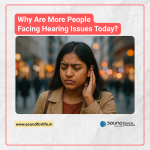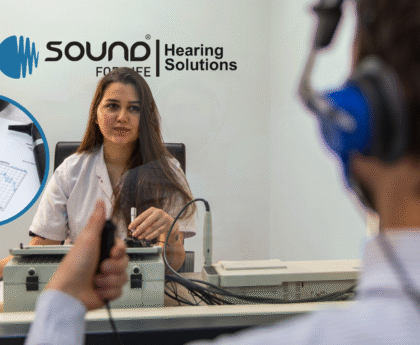Why Are They So Expensive? What You Need to Know:
Why do hearing aids cost so much? Many people ask this question, particularly when they
see how expensive, when they cost typically ₹3.5 lakh or above for a pair. The price alone may be a
major deterrent for people who have hearing loss. However, why are they so expensive? In
this blog, let us analyse the reasons that lead to the expensive cost, such as the advanced
technology included in these tiny devices and the professional services that come along with
it. We will also look at whether they are more beneficial to daily life and truly justify the
investment. Let’s see if the expense is indeed really worth the price.
The Rising Cost of Hearing Aids:
It’s a valid observation that while the cost of many consumer electronics has decreased over
time, the price of hearing aids has, in fact, doubled since 1997. This prompts the question of
what has changed and why prices aren’t following the downward trend seen in other
technological sectors. Actually, hearing aids are not just a simple device that amplifies sound
and makes everything louder. They’re packed with cutting-edge technology designed to
improve your hearing experience. Here are some of the amazing features modern hearing
aids offer how indeed it justify its price tag:
Key Factors Driving Up Hearing Aid Costs:
Extensive Research and Development (R&D)

A significant amount of the cost is invested on to the continuous research and
development by hearing aid manufacturers. Every year millions of amounts are spent
to make hearing aids more compact, more powerful, and equipped with advanced
features. This involves creating technology for channel switching, Bluetooth
connection, wireless capabilities, echo reduction, and improved performance in noisy
areas. A group of highly qualified experts, including computer programmers, sound
engineers, electrical engineers, and audiologists, are involved in this research and
development. These are not low wage occupations, it costs money to have the knowledge and skills necessary to conceptualise and
create these features.
Small Market Volume

Hearing aids aren’t like your everyday gadgets such as smartphones or tablets. The
market for them is much smaller, which plays a big role in their high cost. For
instance, back in 2015, all the hearing aid companies together sold only about three
million units. In comparison, hundreds of millions of smartphones are sold
simultaneously by a single brand at the same time. However, hearing aids
manufacturers lose out on the cost-saving advantages of mass production as they
make them in considerably smaller quantities. Without those economies of scale, the
cost to make each device remains high and that contributes to why they are so
expensive.
Industry Structure and Limited Competition

A small number of multinational corporations typically six or seven main players
control a considerable portion of the hearing aid market. An oligopoly is produced
when these businesses control a sizable portion of the worldwide market. Although
it’s not a complete monopoly, it does mean that there is less competition to drive
down prices. There isn’t as much pressure to provide cheaper costs as there is in
more competitive businesses. Additionally, larger brands frequently acquire smaller
businesses as they begin to attract attention or provide innovation. Pricing power
remains in the hands of a select few due to this firm hold on the market.
Manufacturing Complexity and Customization

Modern hearing aids are extremely sophisticated medical equipment with many little,
intricate parts; they are much more than simply little devices. Each device for in-the
ear styles must be specially shaped to fit each individual’s ear canal, which requires
patience, skill, and accuracy. To precisely match the user’s hearing loss profile, even
behind-the-ear devices need to be meticulously programmed by a qualified hearing
care specialist. As shown in a CNBC video, building these devices isn’t simple, it
involves skilled technicians carefully assembling delicate parts using specialized
tools. The total cost of hearing aids is greatly influenced by all of this.
Professional Services and Aftercare

The price of the hearing aids is not for the device only, it often includes the essential
services rendered by certified hearing care specialists and audiologists. Hearing care
professionals invest a lot of time with each patient, frequently over several
appointments, to fine-tune hearing aids for the best possible fit and performance.
This bundled cost typically covers comprehensive hearing assessments, the
selection and fitting of the hearing aids, programming and adjustments, and ongoing
support and aftercare. The final price also covers the costs of running a hearing
clinic, including rent, staff salaries, and specialist equipment. These services and
administrative expenses not only raise the price of hearing aids but also ensure that
users have the right fit, comfort, and long-term care for their hearing requirements.
Durability and Reliability

Hearing aids are devices which are used every day for a long period of time and
constantly exposed to things like dust, dirt, and moisture. As a result, producers work
hard to make them durable, dependable, and long-lasting. Because of this, the
makers are emphasizing on its durability, and this is one of the reasons contributing
to the high cost of hearing aids. They are made to last years of normal wear and tear,
so they are more than simply fragile devices. Many models are made with high
quality materials and advanced technology to ensure they keep working well over
time, making them a long-term investment in better hearing and overall quality of life.
Warranties and Return Policies

Warranties and money-back guarantees are great for customers, but they also raise the
overall cost of hearing aids. If someone returns a device, because of hygienic and
performance requirements, a device is typically not resalable. That means the provider or
manufacturer has to bear the financial burden. Although these return policies are in place to
provide users peace of mind and time to adjust, they do come with a hidden cost associated
with it. Companies build that risk into the price, which is why hearing aids may seem pricey,
but it’s part of ensuring customer satisfaction and support throughout the journey.
Are Expensive Hearing Aids Worth It?
Hearing aids are expensive, but when you understand the advanced technology,
customization, and professional care that go into them, the cost makes more sense. it is an
investment, considering its importance and its contribution towards your well-being and
standard of living. Considering its contribution towards your general well-being, Hearing aids
are not just the device that help you hear clearly,
● It boosts your confidence
● It helps you stay connected
● Communicate more effectively
● Makes your everyday life easier
For basic hearing needs, even less expensive devices can be effective, although more
expensive ones usually provide more functionality and more flexibility. It is essential to work
with a trustworthy audiologist who can assist you in selecting the finest alternative for your
requirements and financial situation.
The Emergence of Over-the-Counter (OTC) Hearing Aids:
In an effort to increase easy accessibility, over-the-counter (OTC) hearing aids have been
introduced recently, these devices might come in lower costs but lack maximum sound
output and do not require a medical exam or professional fitting. Although it’s yet unclear
how OTC hearing aids will affect the cost of prescription devices in the long run, they offer a
more affordable entry point for some individuals. However, it’s important to note that not
everyone can benefit from over-the-counter solutions, especially those with specific
requirements or more severe hearing loss.
The high cost of hearing aids is caused by a number of factors, including the relatively
limited market size, the complexity of production, the necessity for professional services for
fitting and maintaining the device, and intensive research and development. Considering the
advanced technology, the comprehensive care often included in the price, and the
substantial improvements in quality of life, communication, and overall well-being that
hearing aids can provide, the expense can be viewed as an investment in one’s health and
future. Those who are looking for hearing solutions it is advisable to consult a qualified
hearing care professional to discuss their specific needs. It is important to analyse different
levels and price alternatives, and choose the most suitable and economical solution for their
situation. Initially the cost may seem to be overwhelming but better hearing can have
priceless long-term advantages.





